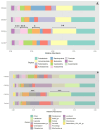Dietary Chia (Salvia hispanica L.) seeds oil supplementation augments growth performance and gut microbial composition in Labeo rohita fingerlings
- PMID: 39805931
- PMCID: PMC11730598
- DOI: 10.1038/s41598-024-83102-2
Dietary Chia (Salvia hispanica L.) seeds oil supplementation augments growth performance and gut microbial composition in Labeo rohita fingerlings
Abstract
The present study investigates the supplemental effects of chia seed oil (CSO) on the growth performance and modulation of intestinal microbiota in Labeo rohita fingerlings. Four diets were formulated with graded levels of CSO: 1.0%, 2.0%, and 3.0% represented as CSO (1), CSO (2), and, CSO (3) groups alongside a control group without CSO. L. rohita fingerlings (n = 180) (mean weight = 19.74 ± 0.33 g) were randomly distributed in triplicates for 60 days to these treatment groups. The results depicted significant improvements (p < 0.05) in weight gain (WG) %, specific growth rate (SGR), feed conversion ratio (FCR), and feed conversion efficiency (FCE) in the group supplemented with the lowest level of CSO. Gut microbial analysis evidenced the ability of CSO at 1.0% to augment the relative abundance of bacterial phyla such as Verrucomicrobiota, Actinobacteria, Bacteroidota, Fusobacteria and Firmicutes, as well as genera Luteolibacter and Cetobacterium, indicating higher alpha diversity compared to the control. Principle coordinate analysis (PCoA) demonstrated a distinct composition of microbial communities in CSO-supplemented groups relative to the control (p < 0.001). Correlation analysis further revealed a significant (p < 0.05) association of specific microbial taxa with growth performance parameters. The predictions of metabolic pathways suggested the involvement of carbohydrate and amino acid metabolic pathways in the CSO (1) group, indicating improved nutrient transport and metabolism. Overall, the findings highlight the beneficial effects of 1.0% CSO supplementation on growth performance and modulation of gut microbiota in L. rohita fingerlings.
Keywords: Labeo rohita; 16S rRNA amplicon sequencing; Chia seed oil; growth performance; intestinal microbiota.
© 2025. The Author(s).
Conflict of interest statement
Declarations. Competing interests: The authors declare no competing interests.
Figures








Similar articles
-
Chia (Salvia hispanica) Seed Oil Modulates the Haemato-Immunological Response, Antioxidative Status and Cytokine Gene Expression of Tropical Freshwater Teleost, Labeo rohita.Biology (Basel). 2025 Jan 18;14(1):95. doi: 10.3390/biology14010095. Biology (Basel). 2025. PMID: 39857325 Free PMC article.
-
Improvement in the growth status and carbohydrate utilization of Labeo rohita (Hamilton, 1822) fingerlings with dietary supplementation of chromium picolinate.Fish Physiol Biochem. 2021 Apr;47(2):599-616. doi: 10.1007/s10695-021-00934-9. Epub 2021 Feb 21. Fish Physiol Biochem. 2021. PMID: 33611776
-
Chia Oil (Salvia hispanica L.) Improves the Intestinal Health of Wistar Rats Fed a Hypercaloric Diet.J Am Nutr Assoc. 2025 May-Jun;44(4):322-331. doi: 10.1080/27697061.2024.2431271. Epub 2024 Dec 17. J Am Nutr Assoc. 2025. PMID: 39689242
-
Repurposing chia seed oil: A versatile novel functional food.J Food Sci. 2022 Jul;87(7):2798-2819. doi: 10.1111/1750-3841.16211. Epub 2022 Jun 16. J Food Sci. 2022. PMID: 35708201 Review.
-
Therapeutic Perspectives on Chia Seed and Its Oil: A Review.Planta Med. 2018 Jul;84(9-10):606-612. doi: 10.1055/a-0586-4711. Epub 2018 Mar 13. Planta Med. 2018. PMID: 29534257 Review.
Cited by
-
Chia (Salvia hispanica) Seed Oil Modulates the Haemato-Immunological Response, Antioxidative Status and Cytokine Gene Expression of Tropical Freshwater Teleost, Labeo rohita.Biology (Basel). 2025 Jan 18;14(1):95. doi: 10.3390/biology14010095. Biology (Basel). 2025. PMID: 39857325 Free PMC article.
References
-
- Tacon, A. G. J., Metian, M. & McNevin, A. A. Future feeds: Suggested guidelines for sustainable development. Rev. Fish. Sci. Aquac. 30, 271–279. 10.1080/23308249.2021.1898539 (2021).
-
- Adeoti, I. A. & Hawboldt, K. A review of lipid extraction from fish processing by-product for use as a biofuel. Biomass Bioenerg.63, 330–340. 10.1016/j.biombioe.2014.02.011 (2014).
-
- Alhazzaa, R., Nichols, P. D. & Carter, C. G. Sustainable alternatives to dietary fish oil in tropical fish aquaculture. Rev. Aquac.11, 1195–1218. 10.1111/raq.12287 (2019).
-
- Hollingsworth, A. Sustainable diets: The gulf between management strategies and the nutritional demand for fish. World Sustain. Ser. 711–725. 10.1007/978-3-319-63007-6_44 (2018).
MeSH terms
Substances
LinkOut - more resources
Full Text Sources
Medical

